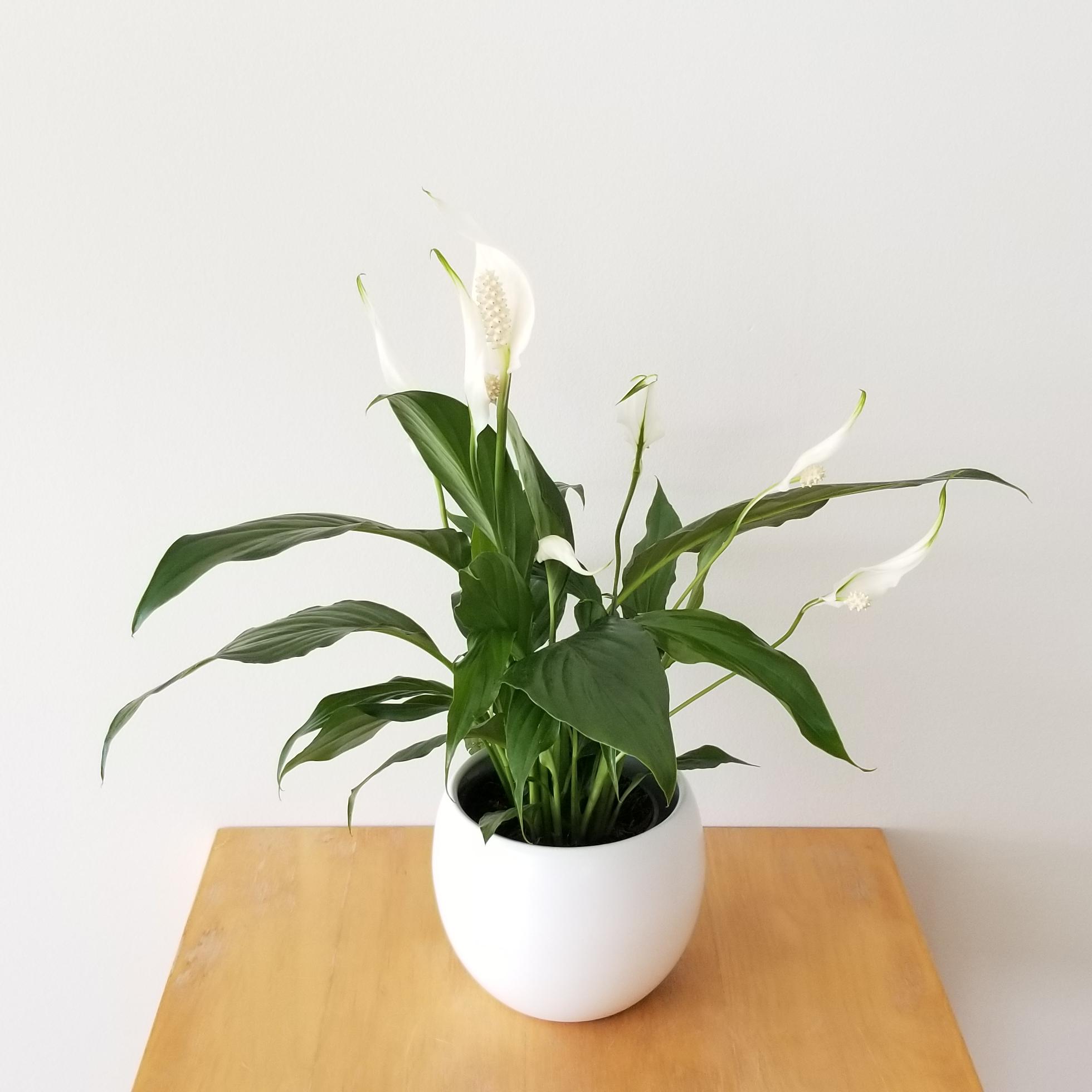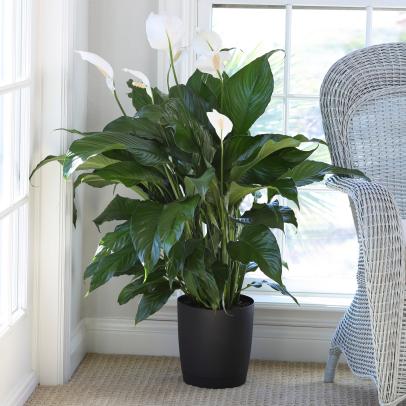Originally a tropical plant that was found on forest floors, peace lilies are now a stylish addition to the plant family in contemporary houses all over the world. This is why it may be concerning to notice that its delicate white blossom is starting to turn brown or to spot blackening points.
This post will examine every potential cause, get to the heart of the issue, and take on the solution head-on.
Table of Contents
Why do Peace Lily Flowers turn brown?
The peace lily is no exception, with flowers having a lifespan that can range from 10 days to a month. Every flower has its own natural cycle.
If your plant is otherwise healthy, the browning of your peace lily’s flower is typically caused by the conclusion of the flower’s life cycle.
Having said that, if you notice that your flower is prematurely turning brown or black, you must investigate the cause in order to keep your plant healthy and in bloom the following year. Every indoor plant, after all, has a special set of needs that it must meet to stay healthy and extend its lifespan.
There are several reasons why peace lily blossoms become brown or black:
- Moving your plant to a new spot in your house can have a significant impact on its health because it may introduce a warm or cool draft, which will change the plant’s ideal environment.
- Browning of the tips can result from either over or underwatering the soil.
- While some plants benefit from poor soil mix varieties’ ability to retain water, peace lilies can become ill and develop brown tips on their flowers and leaves. The same outcome will occur if the soil is compacted tightly because it makes it difficult for the roots to breathe.
- One of the most frequent causes is an inadequate drainage system. Any potted plant must have sufficient drainage.
- Most areas’ tap water has high concentrations of fluoride and chlorine, which are bad for peace lilies and can cause brown or blackened flowers and foliage.
- When conditions are excessively moist, such as damp peace lily leaves and flowers for an extended period of time, fungus and rot flourish.
Should you cut off brown Peace Lily flowers?
All plants benefit from routine pruning, trimming, and removal of old, wilting flowers and foliage to keep them looking good and to promote growth, but browning peace lilies require specific attention.
Whether or not you are aware of the reason of the brown (or blackened) spots on your peace lily, it is always advisable to remove them to prevent the problem from spreading to other parts of the plant or even nearby plants.
In addition, removing dead or dying plant leaves makes sense logically because they no longer provide food to the plant.
How to Remove Browning Peace Lily Flowers?

To prevent extra stress and damage to your plant, it’s crucial to remove the dead branches and blossoms with a clean pair of kitchen scissors or pruning shears.
Even if the foliage is not browning, removing it keeps the plant’s nutrients from being diverted, allowing it to concentrate its energy on future growth and blooming.
Cures for Browning or Blackening Peace Lily Flowers
Peace lilies are very easy to care for, which makes them popular as office plants or presents. However, even a small change in care can cause your plant to stop blooming, die early, or become ill.
It might be challenging to keep in mind each indoor plant’s specific care requirements, especially if you have several of them.
It’s doubtful that bugs are to blame for the browning or blackening if your peace lily is indoors. This leaves inappropriate care as the most likely reason.
Inadequate care may be the primary cause of the browning or it may be a symptom of the plant’s stress, which causes it to focus its energy on preserving the foliage rather than the blossoms.
Fortunately, even though there may be a variety of causes for your lily’s early browning, once you’ve removed the diseased or browning flowers, following a straightforward care regimen is typically all that’s required to restore them to health.
By doing this, you will resolve any present problems and stop them from recurring.
Weekly care guide for Peace Lily
Watering must be done first thing in the morning and only after the potting mix has dried out by one-third. By putting your index finger into the potting mix, you may verify this.
It is preferable to return in a few days if the soil feels damp when you knuckle down in it. By following this general rule, you can prevent overwatering your peace lily and ensure that any water droplets on the leaves will disappear throughout the morning.
Make careful to use distilled water to water your peace lily if your neighborhood has hard tap water.
In order to avoid the growth of fungus and mold, which love stagnant water, adequate drainage is essential. Make sure your pot’s bottom has lots of holes so that any excess water can drain through. It’s crucial to drain any extra water that accumulates in the ceramic pot or outer dish.
The amount of light your peace lily receives has a big impact on how healthy it is. Even if shaded by a window, it should be in a room with plenty of natural light but never in the sun.
It’s crucial to have airflow. This indicates that the center of the room is preferable over a stuffy corner for your peace lily.
At the same time, it is crucial that it be placed away from drafts, particularly air conditioning and heating units, as these will disrupt the local environment and exhaust your lily.
Your peace lily’s best buddy is humidity. Since plants originally grew on forest floors, it is usually a good idea to try and replicate that habitat as closely as you can.
Most of the environments in our houses have enough humidity, but if you live in a very dry region, you might try placing a tray of pebbles and water near your peace lily or misting it every day to increase humidity.
Rosemary Turning Brown: 7 Causes & Treatment
Annual care guid is as follows:
Give your peace lily two annual feedings. both in the beginning of spring and again when summer approaches.
The amount of plant feed that should be used for this should be diluted, and you should add more distilled water than recommended by your preferred brand’s instructions so that the combination is weak.
Since your plant is dormant during the fall and winter, you should never feed your peace lily during these seasons. Because of the mineral buildup, overfeeding your plants will cause browning and blackening of the leaves and flowers.
To give your plant enough time to adapt to its new pot and bloom, repotting your peace lily should also be done in the early spring.
If the roots have completely filled the pot, the Royal Horticultural Society (RHS) advises repotting your peace lily every year.
Repotting more frequently than once a year is not advised because it could stress your plant and impair its health and flowering ability.
It will also be easier to nurture a well-watered, happy peace lily since well-draining compost combined with sand and perlite maintains the soil light and airy.
A helpful reminder is that your plant is pot-bound and has to be repotted if water pours through the drainage holes as soon as you water it.
All plants require trimming at some point, but delicate ones like the peace lily require it more than others.
It is ideal to perform a routine trim in the fall, at the conclusion of the flowering season, along with pruning any blooms or foliage that is beginning to turn brown.
This includes pruning off older outer and low-hanging leaves so that the plant can concentrate its efforts on producing blossoms for the upcoming spring and maintain a tidy, youthful appearance.
How do I know if my Peace Lily is dying?

It’s also crucial to keep in mind that just because one of your peace lilies’ flowers dies does not indicate the entire plant is doomed.
Don’t rush to throw away the entire plant because each bloom only lasts for ten to twenty-one days before starting to fade.
Lily plants in good health go several months without producing new flowers each year. After the plant has finished producing flowers from spring to summer, it goes into dormancy from late autumn to early spring.
On an otherwise healthy plant, it is completely normal for old flowers and leaves to turn brown and die.
Having said that, everything beautiful will eventually come to an end. The symptoms of a dying peace lily are the same as those of an neglected lily.
Consequently, there is no way to tell for sure if your lily is just feeling under the weather or if it is nearing the end of its life.
Following the care instructions above for several months and your lily is still not at its peak could be a sign that your plant is dying.
If you want to enjoy your peace lily blooms for as long as possible, make sure not to make any significant changes to your care regimen or environment once it starts to flower. Your plant can benefit greatly from something as simple as moving it to a different location.
Overall, the Peace lily is a graceful plant that blooms in stunning white and, if properly cared for, will reward you with a profusion of blooms in the spring and summer.
They are a representation of prosperity, hope, healing, and of course, peace. They only need occasional watering to thrive. The ideal finishing touch for any room in your house.
